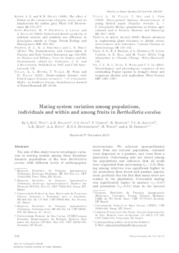Mating system variation among populations, individuals and within and among fruits in Bertholletia excelsa.
Mating system variation among populations, individuals and within and among fruits in Bertholletia excelsa.
Author(s): WADT, L. H. de O.; BALDONI, A. B.; SILVA, V. S.; CAMPOS, T. de; MARTINS, K.; AZEVEDO, V. C. R.; MATA, L. R. da; BOTIN, A. A.; HOOGERHEIDE, E. S. S.; TONINI, H.; SEBBENN, A. M.
Summary: The aim of this study was to investigate variation in mating system among three Brazilian Amazon populations of the tree Bertholletia excelsa with different levels of anthropogenic interventions. We collected open-pollinated seeds from one natural population, remnant trees dispersed in a pasture, and trees from a plantation. Outcrossing rate not varied among the populations and indicates that all seeds were originated from outcrossing (tm=1.0). Mating among relatives was significant higher in the plantation than forest and pasture populations, probably due the fact that many trees are related in the plantation. Correlated mating was significantly higher in pasture (rp=0.47) and plantation (rp=0.51) than in the natural population (rp=0.22), suggesting that trees in natural population are pollinated by a higher number of pollen donors. The paternity correlation was significantly higher within (rp(w)=0.41) than among fruits (rp(a)=0.18), showing a higher probability to find full-sibs within than among fruits. The fixation index was generally lower in seed trees than in their seedlings, suggesting selection for heterozygous individuals from seedling to adult stages. Progeny arrays collected from the natural population had a lower proportion of pairwise full-sibs than in pasture and plantation and higher variance effective size (2.75) than trees in pasture (2.15) and plantations (2.22). Results highlight that seed collections for conservation, breeding and reforestation programs preferentially should be carried out in natural populations due low proportion highest variance effective size within progeny.
Publication year: 2015
Types of publication: Journal article
Unit: Embrapa Rondônia
Keywords: Acasalamento, Acre, Actividades antropogénicas, Amazonia Occidental, Amazônia Ocidental, Ação antrópica, Bertholletia excelsa, Campo Experimental, Castanha do brasil, Castanha do pará, Castanheira, Embrapa Acre, Embrapa Recursos Genéticos e Biotecnologia, Essência florestal, Fitomejoramiento, Flora, Madera tropical, Marcador genético, Marcador microssatélite, Marcadores genéticos, Mato Grosso, Melhoramento genético vegetal, Nuez del Brasil, Polinización, Polinização, População de planta, Repeticiones de microsatélite, Reprodução, Reprodução vegetal, Rio Branco (AC), Western Amazon
Observation
Some of Embrapa's publications are published as ePub files. To read them, use or download one of the following free software options to your computer or mobile device. Android: Google Play Books; IOS: iBooks; Windows and Linux: Calibre.
Access other publications
Access the Agricultural Research Database (BDPA) to consult Embrapa's full library collection and records.
Visit Embrapa Bookstore to purchase books and other publications sold by Embrapa.

